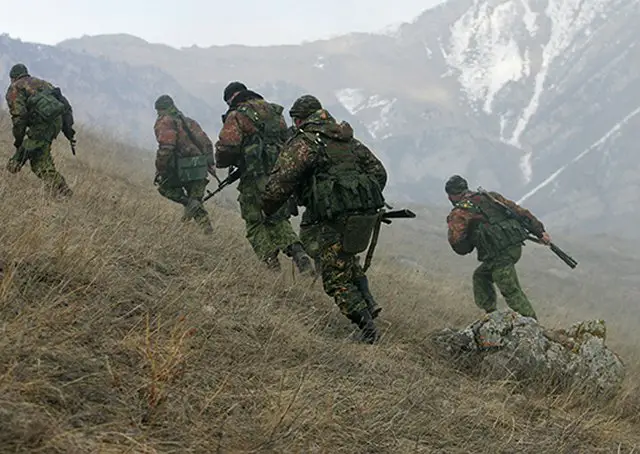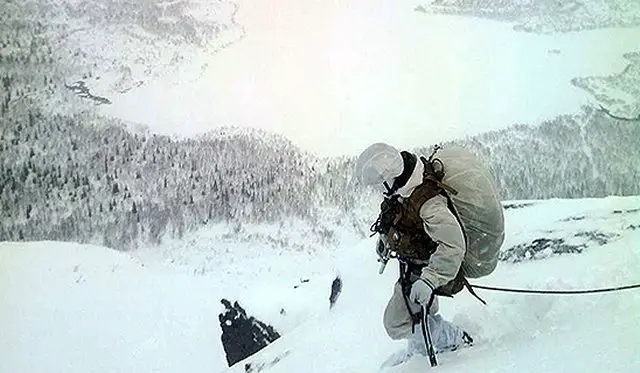|
|
|||
|
Defence & Security News - Russia
|
|||
|
|
|||
| Russian troops master new mountain combat tactic | |||
|
Russian ground forces will hold seven international exercises in 2016, including the first ever manoeuvres with Pakistan, according to Commander-in-Chief or the Russian Ground Forces Oleg Salyukov.
|
|||
|
|
|||
 Special exercise in mountainous terrain will also be held in 2016 (Photo Russian MoD) |
|||
|
|
|||
|
"In the framework of interaction with foreign colleagues we plan seven joint exercises in 2016 with engagement of units from foreign states. The first Russian-Pakistani special exercise in mountainous terrain will also be held," he said.
Experts believe the mountain warfare radically differs from that on plain. Combat tactic in highlands differs from middle and lowlands and ignorance of the difference may result in a defeat. Lowlands comprise that part of a mountainous country which lies at an altitude of 500-1500 meters above the sea. That can be a range of low mountains which is next to their feet or a bottom of major valleys running from foothills practically along the whole of a mountainous country to its center, or the bottom of side valleys in the limits of the mentioned maximum altitude. Lowlands in Pamir, Karakorum and Himalayas are up to 2500 meters above the sea. Troops can advance in that part of a mountainous country only along valleys. Aircraft engagement is complicated by specific air flows and more efficient fire by anti-aircraft missile guns and complexes compared to the plain. Wheeled artillery and armor can move only along roads because slopes and the bottom of the valleys are often blocked by boulders or small crags which create obstacles not only for wheeled but also caterpillar vehicles. Long-range cannon and missile artillery can be positioned on the valley bed and flat terrain if there are roads to reach there. It cannot be done on slopes as they have no tableland and there is no time to make it. |
|||
|
|
|||
 The mountain warfare radically differs from that on plain. Combat tactic in highlands differs from middle and lowlands and ignorance of the difference may result in a defeat. (Photo Russian MoD) |
|||
|
|
|||
|
In lowlands warfare attack helicopters, salvo fire systems, heavy flame-throwers are essential to support the offensive of first echelon troops. In all cases they should not fire at slopes over the advancing troops.
Armor cannot drive cross-country. It can only use roads in gorge beds or those spiraling up the slopes. Attack and tactical bombers can strike only at objects in the deep rear of the enemy to avoid hitting their own troops. Marching second and third echelon troops, reserves and rear units should always have night vigils and be ready for surprise attack. Experts say it is inappropriate to deliver heavy armaments to slopes and tableland which have no roads. If artillery cannot reach the enemy army and tactical aviation shall be engaged. However infantry can bring small artillery pieces and light mortars even to the top of ranges. Or they can be airlifted there by helicopters. For river crossing it is preferable to span bridges. Infantry can use zip lines. It is very dangerous to ford mountain rivers for personnel and hardware. Experts believe it is impossible to assault tunnels head-on. Such attempts result in major losses and complete collapse of the tunnel. Therefore, tunnels are usually seized from the other side with bypassing groups or tactical airborne assault. Middle lands lie at an altitude of 1500-300 meters above the sea (from 2000 to 4000 meters in Himalayas). While advancing into a mountain country it is necessary to send some forces into side gorges to prevent flank attacks and subversions that can trigger landslides or flooding of the valley. Side gorges can be also used by units to bypass enemy defense lines. Special mountain infantry is necessary to fight in the upper middle lands and higher. The engagement of untrained infantry can result in major losses. In the absence of roads hardware cannot reach terraced valleys. Only baggage animals can be used on trails to transport artillery pieces, munitions and other loads. At altitudes higher than 2300 meters thin air makes unprepared people gasp, feel quickly exhausted and uncomfortable. Untrained soldiers cannot move on mountain terrain which poses a mortal danger for them. In case of an upwards attack along smooth slopes the constant danger of a rock fall is to be considered. Ascent by steep grassy slopes is very dangerous. Grass is slippery by itself and hard to walk. It is difficult to stop sliding down in case of a fall. Numerous stones and rocks make any fall dangerous for life. There is no place to hide from rock falls on grassy slopes. It is possible to move upwards in combat order only along big and medium slides and only on foot. Big slides are difficult to pass but have numerous natural hideouts and ensure covertness of approach to enemy positions. Artillery support to the infantry is possible. It is easier to move on medium slides but there is no place to hide and artillery support is impossible because of rock fall danger. In winter snow and frost add frustration for the troops. Alpine skiing skills are important for soldiers. Any heavily snow-covered slope steeper than 15 degrees is fraught with the danger of avalanche. It is important to correctly choose the direction of movement on such slopes. The use of artillery and attack aircraft demands specific skills as they can trigger avalanches. Wide mountain passes usually have several false passes which are good for defense in depth. An assault has to be preceded by thorough reconnaissance of enemy positions and fire power both on the pass and the other side of the range. Bypassing forces have to be dispatched in advance. In the mountains tactical advantage belongs to the highest. Mountain training of infantry has key significance. Fire from small arms in the mountains differs from the plain. When shooting downwards the bullet goes further than in upward fire. Thin air makes 5.54-mm caliber guns inefficient and it is better to use 7.62-mm caliber. Sniper fire is specifically important. All effective long-range shots from sniper rifles (over 2000 meters) were fired downwards in the mountains. It is efficient to support infantry in the mountains with flame-throwers Shmel, AGS-40 and Pecheneg machine-guns. In case of a possibility to reach the enemy rear by trails the strength of the bypassing unit can be up to a battalion. In case of air supremacy it is appropriate to land airborne assaults in enemy rear from helicopters. If there is no air supremacy small groups (up to 15 men) should be engaged to advance to enemy rear. They can gather in a defined place close to the target of an attack. Every person needs acclimatization to operate at a height of over 3000 meters above the sea (5000 meters for Himalayas). Otherwise soldiers can get height sickness or hypoxia which can develop into pulmonary or cerebral edema with unpredictable consequences. Long stay in high mountains is undesirable even with acclimatization. At altitudes above 7000 meters combat activities are impossible. Even in the presence of roads hardware cannot operate at heights above 4500 meters because of a lack of oxygen. Engines will stop. The use of army aircraft in high mountains is limited. The practical ceiling of attack jets and helicopters is low and they become a good target for large-caliber machine guns and anti-aircraft weapons. Helicopters cannot deliver airborne assault at such heights. Soldiers should be properly equipped for combat at such heights. Fighting can proceed only on foot. Units should be manned mostly with climbers. Small groups up to a platoon should be engaged. Valley glaciers are properly visible and should be crossed only in bad weather when clouds reduce visibility to zero and the sounds of moving troops are silenced by storm. Soldiers have to be trained to cross glaciers and orient on the terrain in stormy weather. High mountain passes are difficult to reach and cross but can be used to advance to the enemy rear. Major forces and hardware cannot cross them. If it is necessary to attack a high mountain pass it is to be remembered that quite a time will be necessary for mobile groups to reach the flanks of the enemy. They will have to bypass it through neighboring gorges and then move along narrow trails with difficult rocky terrain. High mountain passes to which roads lead should also be attacked on foot. Artillery support to the infantry is possible only at flat sections of the pass and on back slopes after it is crossed. |
|||
|
|
|||
|
© Copyright 2016 TASS. All rights reserved. This material may not be published, broadcast, rewritten or redistributed.
|
|||














